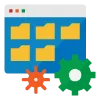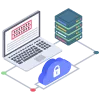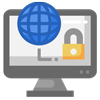
Evaluating the Best Data Storage, Access, and Backup Options for Small to Medium-Sized Businesses
In the modern business landscape, data forms the backbone of strategic decision-making. For small to medium-sized businesses (SMEs), efficient data storage, access, and backup solutions are critical for optimal productivity, operational efficiency, and business continuity. This article explores the factors SMEs should consider when deciding between in-house servers, cloud servers, and Network Attached Storage (NAS). We'll delve into the importance of evaluating storage growth, software licensing, management, and additional network appliances for security, speed, and accessibility both in-house and externally.
Understanding Your Options: In-house Server, Cloud Server, and NAS
Before discussing the factors influencing your choice, it's essential to understand what in-house servers, cloud servers, and NAS are, and what they each bring to the table.
In-house servers: These are physical servers located within your business premises. They provide total control over your data, but require in-house resources for maintenance, upgrades, and security.
Cloud servers: These are virtual servers available over the internet, hosted by third-party providers. They offer scalability, flexibility, and reduced infrastructure costs, with maintenance and security typically included in the service.
Network Attached Storage (NAS): NAS is a dedicated file storage system that allows multiple users and client devices to retrieve data from a centralized disk capacity. They are perfect for small businesses needing local, quick, and reliable access to data from multiple networked devices.
Key Factors to Consider
- Productivity - The impact of your data solution on business productivity is crucial. When evaluating options, consider how they will affect the speed and efficiency of data access and processing. In-house servers can provide fast access within the local network but can be challenging to scale up as your needs grow. Cloud servers, with their scalability, can boost productivity by providing access to data from anywhere, ideal for remote teams. However, reliance on internet connectivity could be a drawback. NAS systems, while offering local, quick access to data, may face performance issues if many users are accessing the system simultaneously.
- Storage Growth - Anticipating your future storage needs is essential. If your business data is growing rapidly, a solution that scales easily will be a boon. Cloud servers excel in scalability; you can easily upgrade your storage plan as needed. In-house servers can be scaled up, but this will require significant resources for additional hardware, software, and possibly staffing. NAS systems offer a middle ground, allowing for incremental storage upgrades by adding additional drives.
- Software Licensing - Your choice will impact your software licensing needs. Running proprietary software on in-house servers can result in high upfront licensing costs, but you maintain control. Cloud services often come with software-as-a-service (SaaS) options, where licensing costs are spread out as part of your subscription. With NAS, software needs and costs will largely depend on your specific usage requirements.
- Management - Consider the resource cost of management. In-house servers require significant IT expertise for maintenance and updates. Cloud servers offer the advantage of offloading maintenance to the service provider. NAS solutions require management but are generally easier and less technical to maintain than a full server.
Additional Considerations for In-house Networks: Security, Speed, and Accessibility
When selecting a data storage solution, SMEs should also consider the following:
- Security - In an era where cyber threats are rampant, securing your business data is paramount. In-house servers allow for total control over security measures. However, it is crucial to have an expert IT team to install and maintain robust firewalls, intrusion detection systems, and conduct regular security audits. Cloud servers generally offer robust security measures, as part of the services offered by providers. Make sure to choose a reputable provider that complies with industry-standard security protocols and offers data encryption, both at rest and in transit. For NAS, security measures are more reliant on the device settings and the security of your network. It's advisable to maintain robust network security, including a strong firewall and up-to-date antivirus solutions.
- Speed - Speed impacts the efficiency of data storage, access, and backups. In-house servers offer high-speed data access within the local network. However, they may be slower for remote access. Cloud servers are heavily reliant on the speed of your internet connection, which can be a limiting factor. However, their capacity for parallel processing can increase speed for data-intensive applications. NAS devices can offer high-speed data access over the local network, but their speed can decrease when many users are accessing data simultaneously.
- Accessibility - The ability to access data both in-house and externally is important, especially with the rise of remote work. In-house servers might require additional configurations, like setting up a Virtual Private Network (VPN) for secure remote access. Cloud servers shine in this area, offering easy access from anywhere with an internet connection.
NAS devices offer local network access and can be configured for remote access, usually via a web-based interface or a VPN.
Enhancing In-house Networks with Other Appliances
Consider enhancing your network with additional appliances for improved performance, security, and flexibility.
- Firewalls: These provide a security barrier between your internal network and external networks, helping to block malicious traffic.
- VPNs: VPNs allow secure remote access to your network, essential for businesses with remote workers.
- Load Balancers: If you have high network traffic, load balancers can distribute the load across several servers to maintain optimum performance.
- Switches and Routers: Quality switches and routers can improve network speed and performance.
- Intrusion Detection/Prevention Systems (IDS/IPS): These tools can help identify and block potential security threats.
Benefits of in-house servers for SMEs
- Data Control and Security: SMEs can have direct control over their data and security measures. This control allows them to implement robust security protocols, access controls, and encryption methods to protect sensitive information.
- Customization: In-house servers can be tailored to meet the specific needs of the business. SMEs can configure servers with the exact software and hardware specifications required to run their applications efficiently.
- Performance: In-house servers can often provide faster and more reliable performance compared to cloud-based solutions, especially for resource-intensive tasks or applications that require low latency.
- Cost Control: While the initial setup costs for in-house servers can be significant, SMEs have more predictable and manageable ongoing costs compared to monthly cloud service subscriptions. They can also optimize server usage to minimize wastage.
- Data Backup and Recovery: SMEs can establish their backup and disaster recovery solutions, ensuring data resilience and minimal downtime in case of hardware failures or data loss.
- Compliance: In some industries, there may be regulatory requirements that mandate data storage and processing within a specific geographic location. In-house servers allow SMEs to comply with these regulations more easily.
- Full Resource Allocation: SMEs can allocate all server resources (CPU, RAM, storage) exclusively to their own applications and services without sharing them with other users, which can lead to better performance.
- Privacy: In-house servers can offer greater privacy since data is not stored on shared cloud infrastructure, reducing the risk of data exposure due to shared resources.
- Scalability: SMEs have the flexibility to scale their in-house server infrastructure as their business grows. They can add more servers or upgrade existing ones to meet increased demands.
- Redundancy: With appropriate planning, SMEs can implement redundant server configurations to minimize downtime and ensure high availability for critical applications.
- Control Over Maintenance and Upgrades: SMEs can schedule maintenance and upgrades at their convenience, minimizing disruptions to operations.
- Local Support: Having in-house servers allows SMEs to have direct control and access to IT personnel who can provide immediate support and troubleshooting when issues arise.
Despite these advantages, it's essential to note that managing in-house servers also comes with responsibilities and challenges, including initial setup costs, ongoing maintenance, hardware depreciation, and the need for skilled IT staff. SMEs should carefully evaluate their specific requirements and budget before deciding whether in-house servers are the right solution for their business or if a combination of in-house and cloud-based services might be more suitable.
Conclusion
Choosing between in-house servers, cloud servers, and NAS depends on several factors including your business's productivity needs, expected storage growth, software licensing preferences, management capabilities, and desired network security measures. By thoroughly evaluating each of these considerations, SMEs can select the data storage, access, and backup solution that best aligns with their operational requirements and strategic objectives.
The dynamic business landscape demands agility and foresight, particularly in how data is handled. Hence, regularly revisiting your chosen data solution to ensure it remains fit for purpose is a wise move, setting your business up for sustained success in the digital age.
In general:
- Servers: The lifespan of a server is typically around 3-5 years. However, high-quality servers that are well maintained and not under excessive load can last up to 7-8 years. After this period, hardware starts to fail more frequently, and the costs of keeping the server running may outweigh the costs of replacement. Also, manufacturer support and warranties often expire after this time, making it more challenging and costly to maintain the server.
- NAS Devices: NAS devices often last between 3-5 years as well, similar to servers. However, the hard drives within NAS devices can fail more frequently. A NAS hard drive, under heavy use, might last 1-3 years, while under light use, a hard drive might last upwards of 3-5 years. As with servers, well-maintained NAS devices can extend beyond their expected lifespan, but replacing them before they fail often helps avoid data loss and downtime.
In both cases, proactive maintenance and regular monitoring can significantly extend the lifespan. This includes practices such as cleaning dust out of the hardware, maintaining a stable power supply, keeping the devices in a temperature-controlled environment, and regularly updating the software and firmware. Remember to back up your data frequently, so if a device fails, your data is safe.
What are typical proactive maintenance for servers and NAS
Proactive maintenance for servers and NAS devices involves regular checks and updates to ensure the devices continue to operate efficiently and to prevent potential issues before they occur. Here are some typical proactive maintenance tasks:
- Regular Software Updates and Patching: Keep the operating system and all installed software up-to-date with the latest patches and updates to fix bugs and security vulnerabilities.
- Hardware Inspections: Regularly inspect server and NAS hardware for any signs of wear and tear. This can include checking fans for dust and debris, inspecting hard drives for signs of failure, and ensuring all cables are properly connected and undamaged.
- Monitor System Performance: Regularly check system performance metrics to identify potential issues. Tools are available that can monitor server health, including CPU usage, memory usage, disk space, and network performance.
- Backup and Recovery: Regularly back up all data stored on servers and NAS devices. Implement a disaster recovery plan to ensure you can quickly restore data and operations in case of a system failure or data loss.
- Check and Clean Physical Environment: Keep the devices in a clean, dry, and temperature-controlled environment. Dust and other particles can damage hardware, and extreme temperatures can cause systems to overheat and fail.
- Regular Reboots: Regularly rebooting servers can help find issues that only appear on startup and clear out temporary files and processes that may be slowing down the server.
- Replacing Aged Hardware: Aging hardware is more likely to fail, so proactive replacement of old components can prevent unexpected failures.
- Check Error Logs: Regularly check system and application error logs to spot issues that may not be immediately visible.
- Redundancy Checks: Ensure that redundant systems, like RAID arrays or dual power supplies, are functioning correctly. Replace faulty components as needed.
- Network Monitoring: Keep an eye on your network performance. Network issues can affect the performance of servers and NAS devices.
- Antivirus and Malware Checks: Regularly update and run antivirus and malware scans to protect your servers and NAS devices from threats.
Remember, while proactive maintenance requires some time and resources, it is generally much less costly than dealing with reactive maintenance after a problem has occurred.
Ready to take the next step in upgrading your business's IT infrastructure? Let ALL i. t. LLC guide you on your journey towards a secure, efficient, and scalable solution. Our team of experts is ready to evaluate your unique needs and craft a tailor-made, cost-effective plan to transform your data storage, access, and backup systems. Whether you're just starting or looking to enhance existing structures, our commitment is to provide solutions that power your growth.
Don't let IT challenges slow down your business. Allow us to be your trusted partner in navigating the complexities of servers, NAS, and cloud systems.
Your future is just one call away. Contact ALL i. t. LLC today for a consultation and propel your business to new heights of productivity and success.
Call ALL i. t. LLC at 231-375-8682 Now. Let's make IT work for you!










